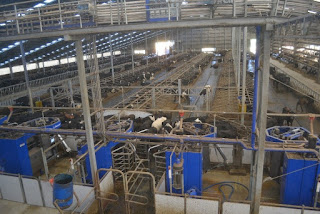Day 11
We left
Te Anau at 8:30 AM for Mt. Linton Station, an operation that runs 3,000 head of
Angus cattle with 850 of them being stud herd, and 45, 000 head of Romney-Texel
sheep. The manager for the Mt. Linton station is Ceri Lewis. He operates the
place with a staff of 20 people. Twelve of them are designated to manage the
stock, and 8 of them are designated for routine management, such as equipment
and fence line maintenance. The cattle program, as mentioned above, is divided
into both a seedstock and commercial operation. Manager Lewis has an annual
Angus bull sale that has grown to sell 400 bulls. The genetics that Lewis
emphasizes are primarily maternal traits with calving ease and fertility. He
then considers carcass traits with an emphasis on marbling due to the Beef
Eating Quality (BEQ), which is similar to our USDA quality grading. For the
BEQ, Lewis targets his market cattle to be 560 kg, with a carcass weight of approximately
300 kg, which converts to 1,234 lbs. and 661 lbs., respectively. He sells his
steers to Silver Fern farms that will market the beef for U.S. imports. This
year, he scheduled to market 1400 steers to Silver Fern Farms. Lewis sources
his genetics out of Australia and practices artificial insemination with his
cattle. He is looking into embryo transplants to help maintain and improve the
genetics of his herd. Currently, he operates the best marbling herd in the
country, but competition is catching up to him via embryo technology.
 |
| Mt Linton Station’s feeder lambs out on pasture. |
 |
|
Mt. Linton Station’s overview of their shearing shed
|
 |
| Mob of Mt. Linton Station Angus steers being transitioned to fodder beet. |
To maintain the fields, Lewis spends approximately $1.8 million on fertilizer consisting of phosphate, potassium, lime, and sulfur. Since the stocking rate is 14 stocking units per hectare, Lewis said that fertilizer plays a significant role in maintaining decent soil health.
 |
|
The group decided to pose for a picture in front of the bus
being stuck. This was the first
occurrence for an SDSU tour group.
|
The crew
experienced a little bit of excitement while touring the Mt. Linton station.
Lewis was on the bus with the students, professors, and tour guide as we were
headed up a steep hill. It rained just prior to arriving and was still
sprinkling as we were headed up the hill. The road was a little too greasy, and
those in the back of the bus could feel the bus sliding around. We came to a
slight curve in the steep hill, and the back end of the bus slid into the
ditch. The students promptly unloaded and called for a John Deere tractor to
come pull the bus out of the ditch. One of Lewis’s men came and quickly pulled
the bus out so that the students could continue the tour. Thank goodness for
John Deere tractors! J
 |
| JOHN DEERE SAVES THE DAY! Picture of the tour bus being towed out by a John Deere tractor. |
Hattie and Samantha




Comments
Post a Comment